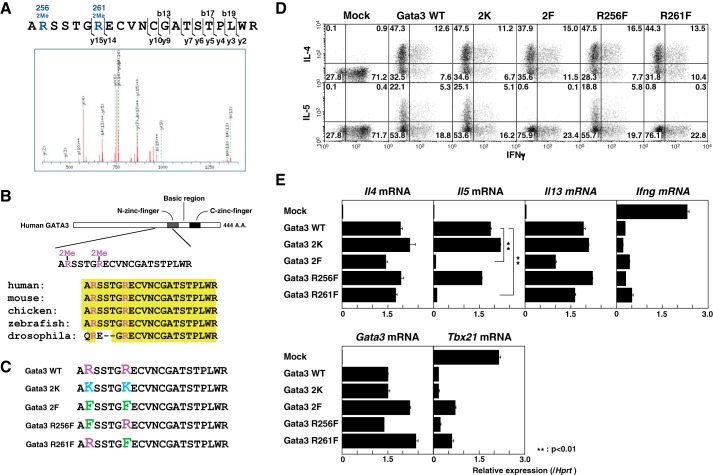FIGURE 1.
Identification of Gata3 methylation and its role in IL-5 production. A, D10G4.1 cells were infected with a lentivirus encoding FLAG-Gata3, and then the immunopurified Gata3 was subjected to an LC-MS/MS analysis to assess the posttranslational modifications as described under “Experimental Procedures.” The mass spectrometry profile of Gata3 residues 255–275 is shown. B, the methylated residues of Gata3 in the N-terminal zinc finger are highly conserved from Drosophila to humans. A.A., amino acids. C, schematic representations of the WT and mutant Gata3 (Gata3 2K, methylation-impaired; 2F, R256F,R261F, methylation-mimic) are shown. D and E, naive CD4 T cells from C57BL/6 mice were stimulated under Th1 conditions and then infected with a retrovirus vector carrying WT or mutant Gata3 cDNAs. Four days later, the cells were restimulated and subjected to IL-4, IL-5, and IFNγ staining, followed by a FACS analysis (D). The retrovirus-infected human nerve growth factor receptor (hNGFR)-expressing cells were purified, and the mRNA levels of Tbx21 and Gata3 were measured by RT-qPCR. To induce cytokine production, the cells were stimulated with an immobilized anti-TCRβ mAb for another 4 h, and then the extracted RNA was subjected to RT-qPCR for Il4, Il5, Il13, and Infg mRNA expression. The relative expression (/Hprt) is shown with standard deviations (E). Mock, mock-transfected. **, p < 0.01 by Student's t test.

